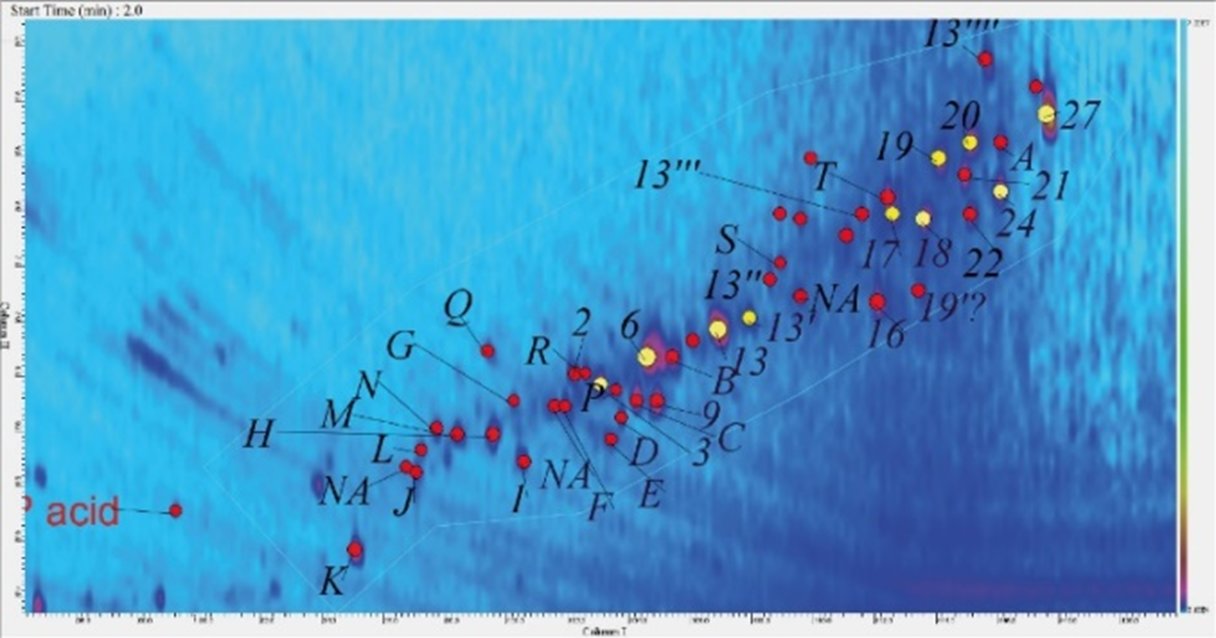|
Introduction
The Center for Research on Preservation (known by its French initials, CRC Centre de Recherche sur la Conservation) is a research and services unit specialised in research aiming at the preservation of cultural property. Part of the research pole deals with ancient Asian papers. Its aim is characterizing Japanese papers, especially the “kôzo” paper (from the kôzo plant), by identifying the chemical markers, specific to each type of paper. A Py-GC/MS technique has already been used for this purpose, giving satisfying results, but it is thought that improved efficiency may be necessary to better differentiate papers and to get more markers. This is why the use of a comprehensive GC was developed. The identification would remain more specific and use less paper amount, so it would be easier to correlate archeological samples to reference papers.
Experimental conditions
Analysis was conducted with a Shimadzu QP 2010-Ultra mass spectrometer equipped with a two-stage thermal modulator ZX 2. Pyrolysis was performed using a vertical micro-furnace-type pyrolyser PY-3030iD. The sample was placed in a stainless steel sample cup. Typical quantities of sample paper used in this work ranged from 20 to 50 µg weighed with an XP2U Ultra Micro Sale. The sample cup was introduced into the furnace at 500 °C, and then the temperature program of the gas chromatograph oven was started (1mn at 100°C then a 2°C/mn ramp until 325°C then 25mn at 325°C). The Py-GC interface was held at 320 °C. The chromatographic separation was carried out on the first dimension (Name Optima-5HT, 30m lenght, 0.25mm inner diameter, 0.25µm coat thickness) and second dimension (Zebron ZB-50, 2,8m lenght, 0.1mm inner diameter, 0.1µm coat thickness) columns, with a loop modulator system (1.5 m dim 2; 1.3 loop).
The separation was carried out at an initial constant pressure of 300 kPa using Helium Alphagaz 1 as carrier gas. The modulator employed a closed cycle refrigerator/heat exchanger to produce a -90 °C cooled air jet 10s-modulated with a pulsed hot air jet, with a programmed hot pulse of 0.350 s. A two-step temperature program was used for the hot jet set at 200 °C for 30 min and subsequently raised to 280 °C.
The injector was held at 280°C and used in split mode (1:30 of the total flow). The mass spectrometer was operated at 20,000 amu s−1, with a scan range of 50 to 500, using electron ionization at 70 eV. The interface was kept at 280 °C and the MS source at 200 °C. Data processing was achieved using GC Image software. Paper components were identified by comparing the mass spectra of unknown components with the ones in the NIST mass spectra library, 2011 edition.
Results
Image 1 is a zoom on the marker zone of the software (GCImage) image. Red dots represent the detected peaks. All the letters and numbers on the image are the identified peaks. On the image, simple numbers are correlated to molecules that were already identified in Py-GC/MS, but numbers with prime, second etc symbols and letters are markers that did not appear in 1D analysis. Previous results provided by Py-GC/MS contained fewer markers than what was found in comprehensive GC. The old method only permitted to identify few compounds whereas the new one showed more, thanks to a much better efficiency. Even though the analysis took a longer time (2h instead of 1h), gain in specificity was high enough to compensate. Indeed, it would be very useful to differentiate similar papers such as “mitsumata” paper and “gampi” paper. Finally, only twenty micrograms of paper were used, which is a very small amount. It appears that a GC 2D method would be the best for this purpose.
Conclusion
Characterizing markers from “kôzo” paper seems more specific and complete with pyrolysis comprehensive GC than usual Py-GC/MS. Regarding the previous analyses, it looks like this method would be the best to characterize paper markers.
|
|

Image 1: zoomed image on the characteristic markers part, on the image resulting from the analysis of “kôzo” paper in comprehensive GC, with GCImage software
|



